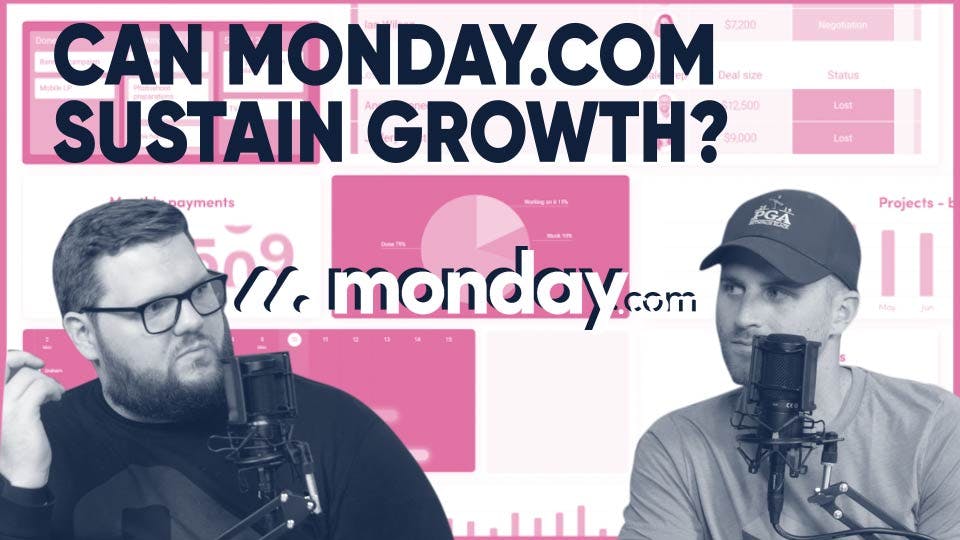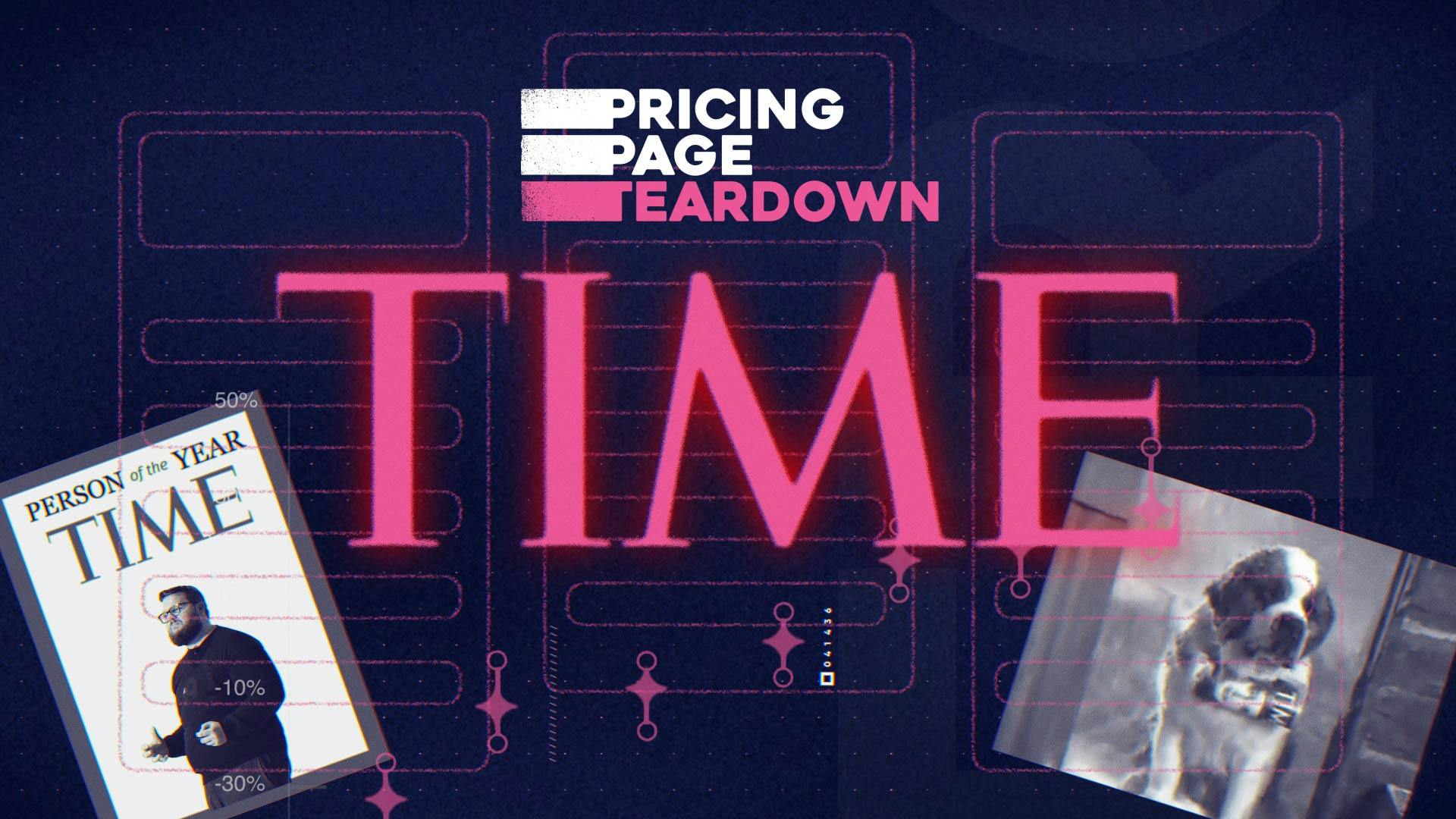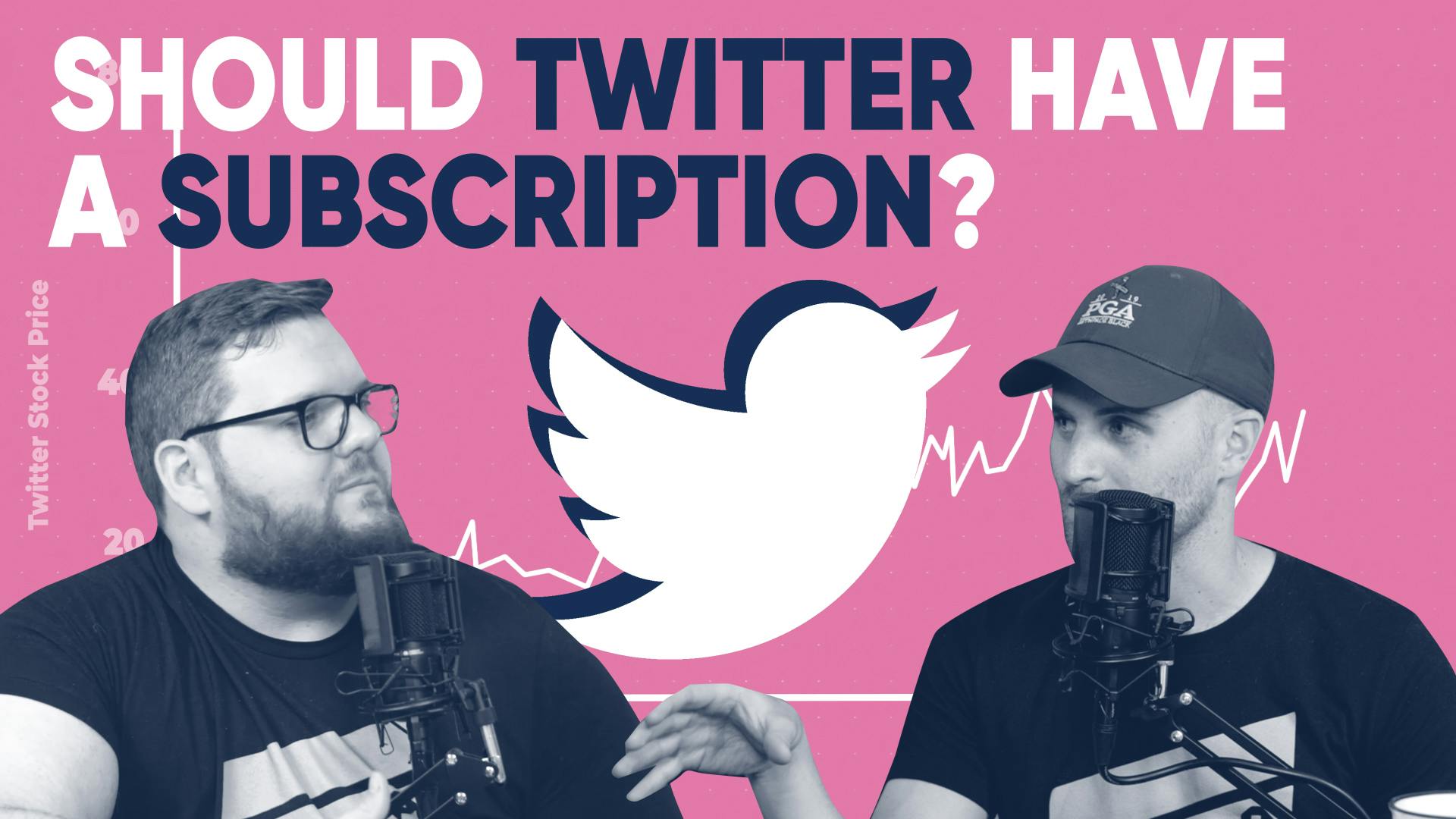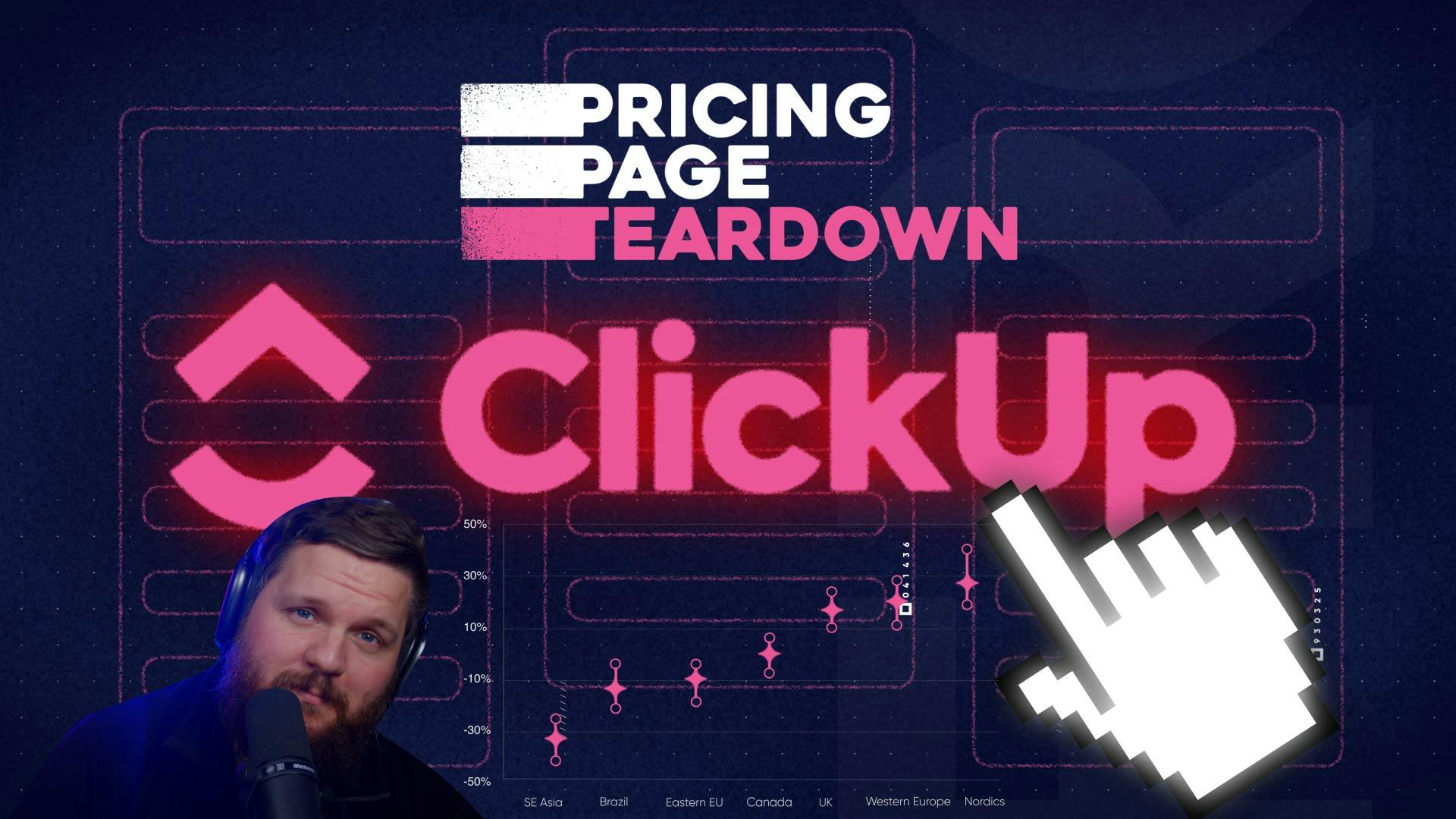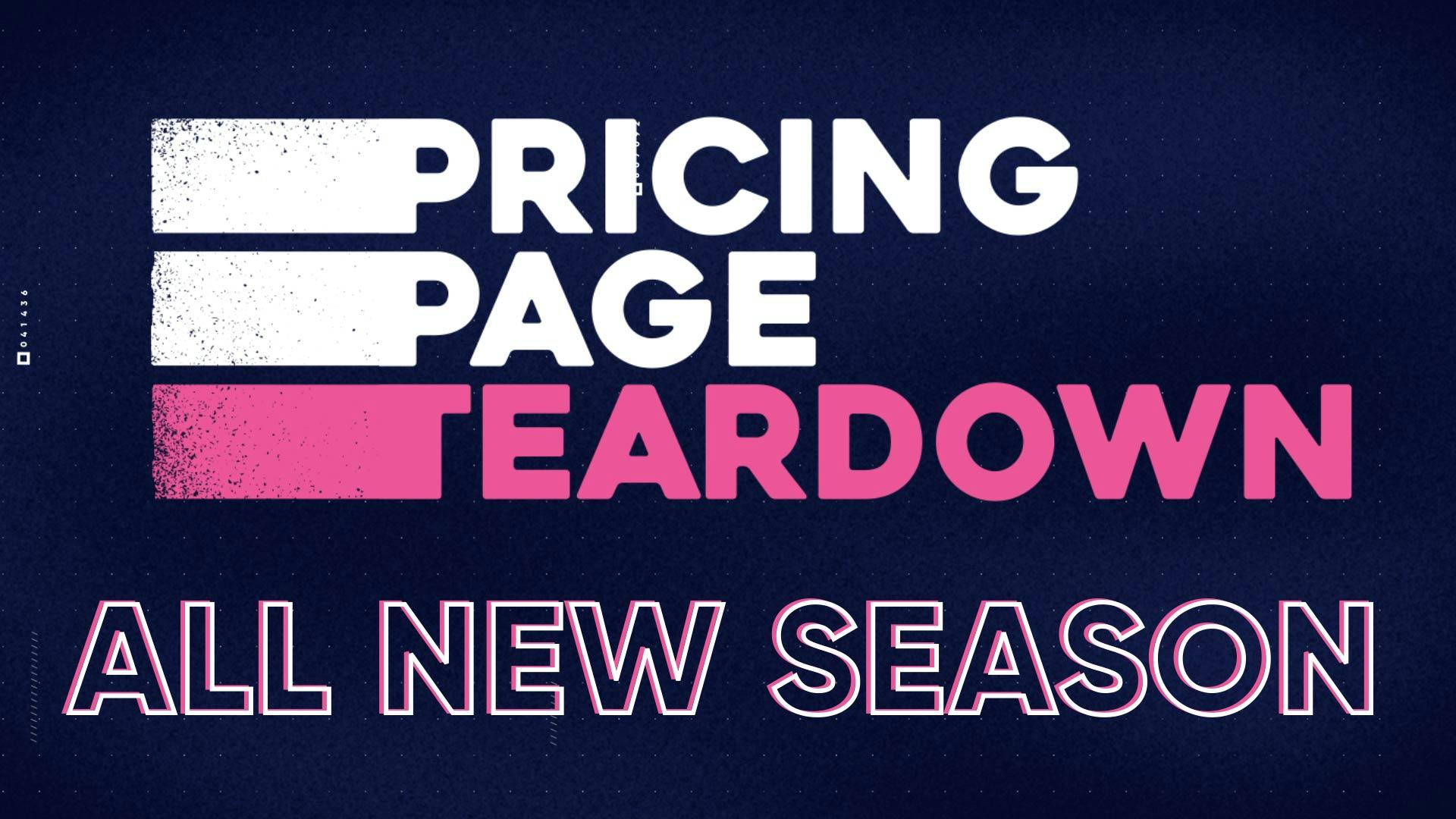
Subscribing to Joe Rogan
This episode might reference ProfitWell and ProfitWell Recur, which following the acquisition by Paddle is now Paddle Studios. Some information may be out of date.
Please message us at studios@paddle.com if you have any questions or comments!
This week, we're talking about a little-known podcaster, who is also a UFC commentator—former host of Fear Factor, and stand-up comedian. And we're talking about a hypothetical Joe Rogan subscription.
The idea of "subscribing" to someone, whether by agreeing with their views or following their content, is becoming more in vogue. And it's not just for podcasters—business creators like us and our media site Recur, as well as a host of other creatives could benefit from this concept. What we want to explore today is:
- Spotify dropped $100 million for exclusive rights to Joe Rogan's podcast—should they have?
- What could Joe Rogan have done to not be tied to Spotify? He's always wanted freedom, so how could he have created his own subscription service that still would have been competitive against the likes of YouTube, Spotify, and Apple Podcasts?
When he first signed the deal, some were saying that Rogan himself was making a larger mistake than Spotify. The data may suggest that's true. But I also think the data will show that making a $100-million deal is never too bad of a decision. In that light, we're going to talk about what Joe Rogan could be doing to monetize his brand and content, all within the constraints he's placed on himself. We'll also take a look at the things he's not doing so well, and bundle all of this information into a case study that's applicable to your own monetization.
Joe’s thirst for knowledge has brought him tremendous success, including the $100M Spotify deal. But was it actually good for him? He was able to keep his editorial freedom, but could there have been more financial gains for Joe staying independent?
Below are some valuable takeaways you can implement in your own business.
- Hone in on your biggest fans.
For those who work in the content world, focus on the people who have a positive or strong positive affinity for you. That's your target market. - Understand why people appreciate your brand.
Content creators should go after their super fans, understand their preferences, and price based on them. Build your brand around those who are going to pay you and drive more users. - Membership actually improves the user experience by taking advantage of community.
All of the things that people prefer inside a membership are things that your listeners, followers, etc., are already doing. Creators should realize that you don't have to create exclusive content. You can ask for the membership and give a few things. As long as you're providing value, people will continue to use it.
Joe Rogan just wants to learn. And that’s what gets him and his podcast into trouble. It’s also what got him a $100M deal from Spotify for exclusive rights to his podcast.
From talking to Bernie Sanders and Alex Jones to Tulsi Gabbard and Elon Musk, as well as an endless stable of comics like Tim Dillon, Tom Segura, and Bert Kreischer—Joe just wants to talk and learn from people without an agenda. This is why people love listening to his podcast—the non-agenda focused questions, learning, and calling B.S. if someone goes too far. This is also why people hate his podcast. He gives sunlight to the ideas from seemingly controversial figures, which causes controversy.
Joe came a long way to this $100M podcast empire though. Growing up in New Jersey, a bit of time in California, and then Boston—Joe had a good, but tough childhood. He found his journey in martial arts when he started lessons at the age of 13 before touring the country in tournaments and even thinking he’d go pro. As Joe said, “[martial arts] gave me not just confidence, but also a different perspective of myself and what I was capable of. I knew that I could do something I was terrified of, and that was really difficult, and that I could excel at it. It was a big deal for me.” That confidence led to four years of Massachusetts full-contact Tae Kwon Do championships.
After getting into the MMA, some head trauma convinced him to shift his career down a less violent path. So, at the age of 22 he entered the aggressive Boston comedy scene. Using his determination and confidence learned in fighting, Joe rose the comedy ranks, moved to LA, and found success in comedy specials, sitcoms like NewsRadio and Hardball, as well as being a long-time color commentator with the UFC since 1997. You also probably know him most from his long-time hosting gig of Fear Factor, which let’s just say, he has some stories.
Joe Rogan's success
In 2009, he started his podcast, “The Joe Rogan Experience,” just as a way to talk to his comic friends. Although Joe admits the early episodes were terrible, within a decade the show gained a massive following with 190 million monthly downloads—especially as his guest list expanded to scientists, authors, political figures, athletes, artists, and really just anyone that Joe finds interesting. Clearly, many other people find them interesting too, as Spotify convinced Joe to go exclusive with that $100M deal.
Joe’s success stems from trying to seek the truth, a refreshing notion in this day and age. Yet, some critics question whether or not the $100M deal was good for Spotify, let alone Rogan, considering he lost some of his audience who didn’t or couldn’t move to Spotify. Sure, he did keep his editorial freedom, but could there have been more financial freedom for Joe staying independent. So the question becomes: How should Joe Rogan monetize his audience in a manner to not only gain financially, but also pull the community together? Is Spotify monetizing Joe’s content properly through ads? Should Joe have a subscription like other artists and creators are doing?
It seems Joe’s doing many things right, but we’re going to explore how he could be doing even more while answering these questions by collecting data from 10,542 current and prospective Joe Rogan fans. Keep reading for the answers to these questions.
Working within his constraints
I got sucked into Rogan's world via video clips on YouTube. All of sudden, he was just in my feed all the time. I'd see things and be like, "Okay, I'll listen to that. I like Tom Segura. I like this topic." From what I gather, he just likes to talk to people who are super interesting and he appreciates understanding new perspectives. When you're creating in the space that Rogan is, that's huge. He's not making it about himself, he's making it about the guest. It allows the listener to feel more included—you're not eavesdropping on a conversation between Rogan and his guest, you're enjoying a guest's point of view alongside Rogan.
He's also done a good job of not alienating any markets. While he's not necessarily apolitical, he has guests with extremely varied backgrounds. He doesn't worry about being "safe" and simply sticks to doing what he loves. It's great but—from a monetization perspective—it also adds some constraints. There are so many more things he could do that would earn him more money, but he's happy where he's at. He's down to keep doing what he's doing and isn't interested in being someone's employee.
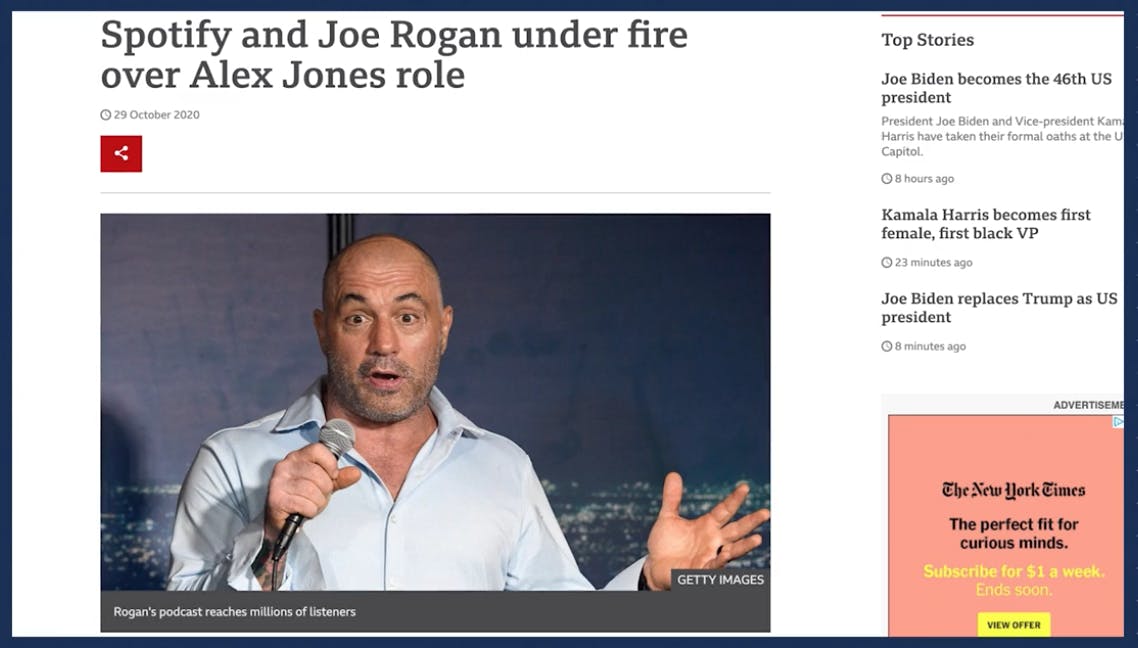
With that knowledge, we're going to talk through what a Joe Rogan subscription could really look like. But these lessons won't just be useless for him. Ultimately, we'll demonstrate how you can monetize subscriptions—content-based or otherwise—and ensure you're doing it the right way.
Where does our data come from?
Here at Paddle, our Price Intelligently software combines proprietary algorithms and methodologies with a team of pricing experts who think about this stuff more than anyone else to help companies optimize their monetization strategy. We do this by going out into the market and collecting data from current and prospective customers, having the ability to collect data from everyone, from a soccer mom or dad in the middle of Kansas, all the way to a fortune 500 CIO in South Africa. We then take that data and run it through our algorithms and analyze it in every direction to determine a company's ideal customer profiles, as well as which segments value, which features and which segments are willing to pay more, all in the spirit of determining how a company can use monetization for growth.
Subscriptions hedge against platform and ad fatigue
A subscription fights back against platform and ad fatigue. One thing we've noticed with creators in the past is that when a particular personality is knocked off a platform, they'll be completely derailed. These folks are typically a bit more controversial, but anyone who experiences one of these bans is a clear example of platform problems.
There are also ad problems. There are a lot of creators who like creating hour-long shows that get into a really specific topic. And while that content is great from a length perspective, the subject matter won't necessarily bring enough volume to be successful. When you're seeking those thousand true fans, the model isn't really right from an ad/platform perspective. It starts to more closely resemble a subscription.
Hone in on your biggest fans
The first thing we wanted to do was collect willingness-to-pay data. This would show us the feasibility of a fan paying someone like Joe Rogan enough money monthly to sustain his particular lifestyle or business. This was calculated by first measuring affinity—when it comes to Joe, are you weak, neutral, or negative? Or maybe even strong, if you're listening to every episode, reading his content, or visiting his Reddit page.
For those who had a weak affinity, the willingness to pay was only $1-$2. Obviously, these people aren't primed to pay anything to support Rogan. They could maybe be persuaded by a good offer, but this probably isn't Joe's target market.
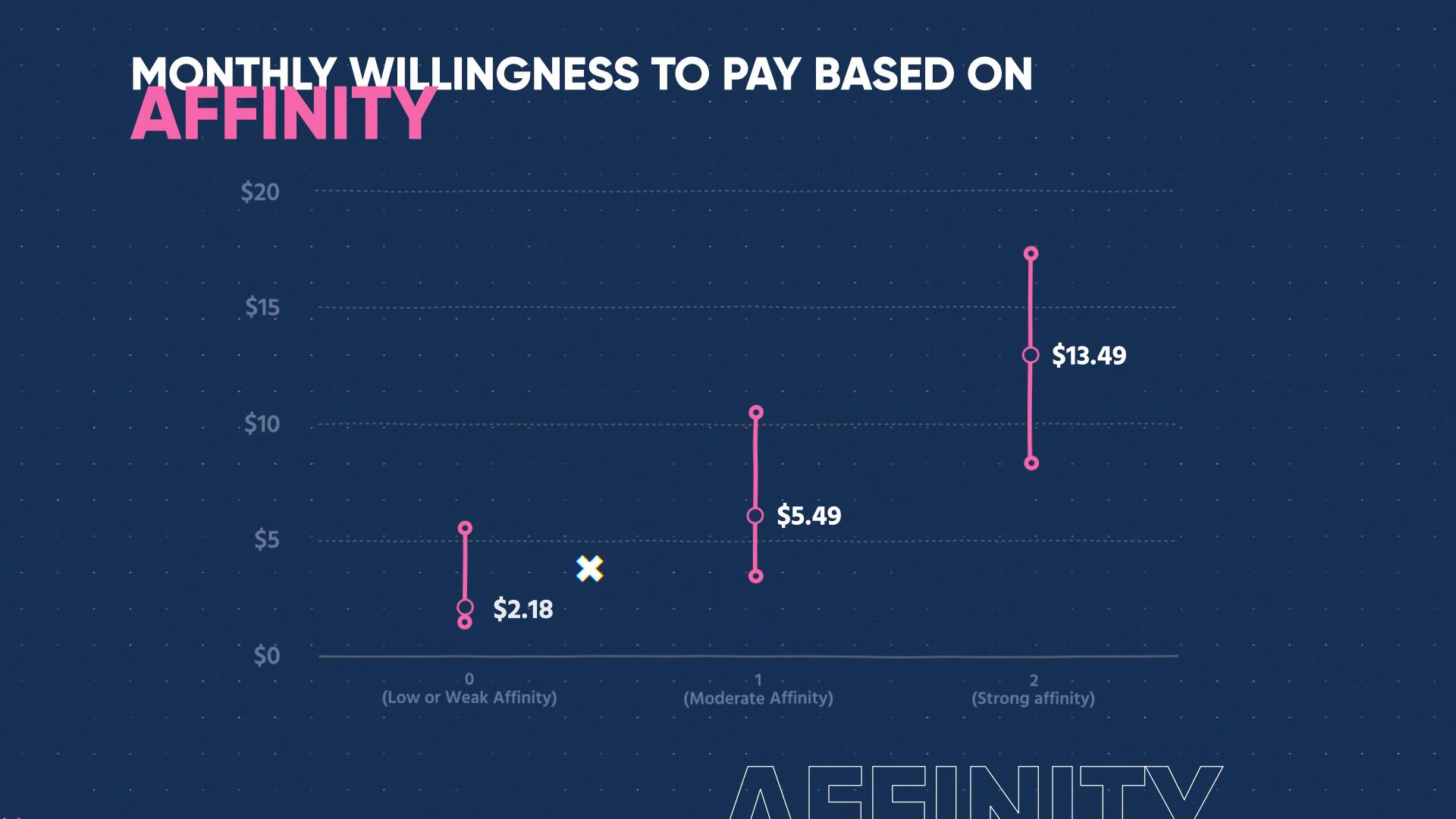
For those who work in the content world, you should focus on the people who have a positive or strong positive affinity for you. Just look here—moderate to strong folks are ready to pay $5-$15 per month for a subscription. That's about $100 per year, per person, plus all of his ad revenue. It's really crazy.
He could even break it down based on his different topics, if you will. He tackles MMA, comedy, and more deep-thinking. If he is able to divide these into separate subscriptions, he could be more deliberate with his advertising and have a huge opportunity for monetization.
Understand why people appreciate your brand
If you're creating content, you have to understand why people appreciate your brand. When we cross-referenced willingness to pay with a listener's favorite topic of Joe's, we learned some really valuable insight. As it turns out, the people who love political or academic commentary are the ones who absolutely adore Rogan. They're also the ones who put him most at-risk on traditional platforms.
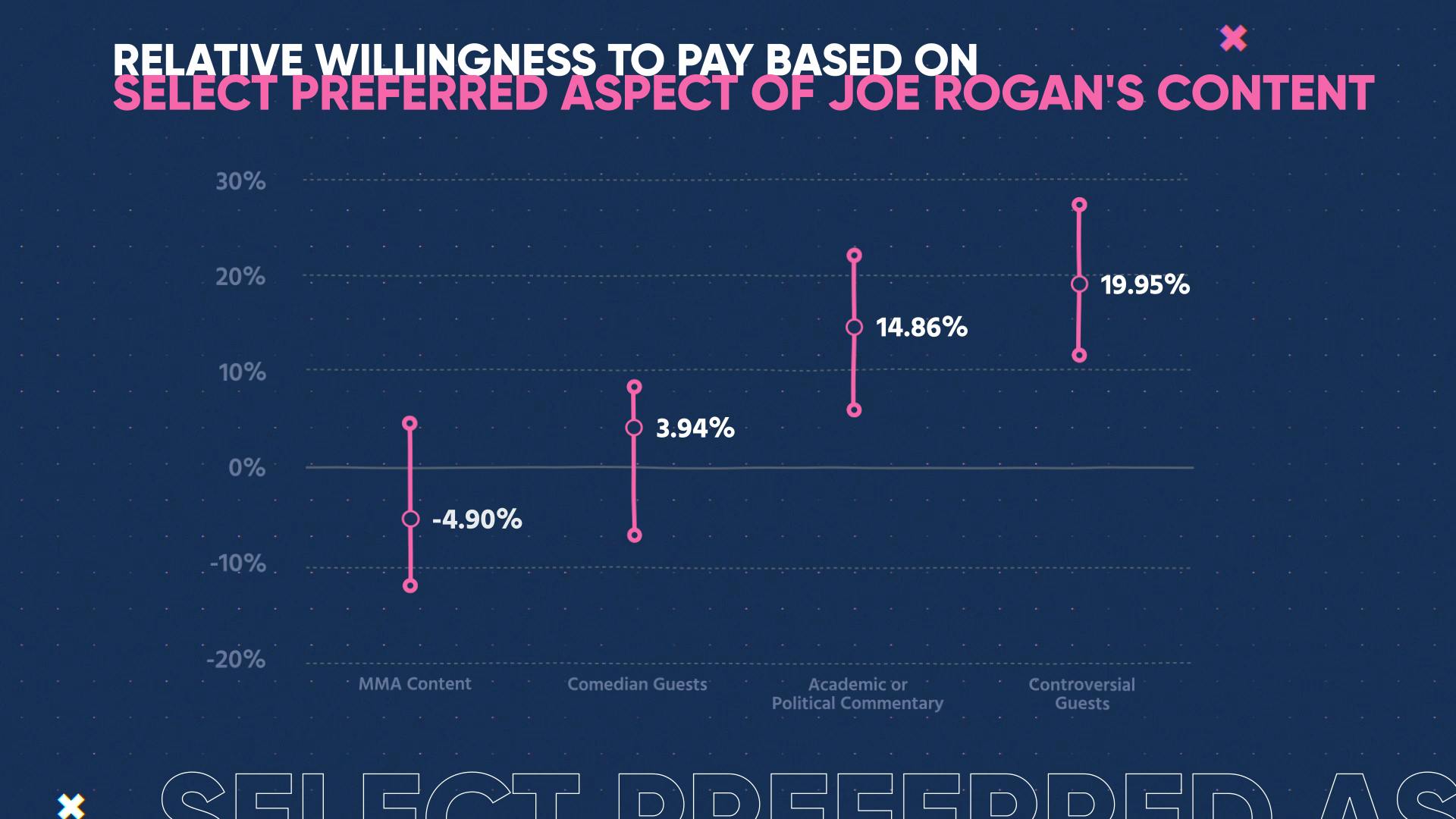
The big takeaway for your business is, if you're doing something in the content space, you have to go after your super fans. Price based on your biggest backers. The folks with a weak affinity are going to turn out anyway. Why build the subscription and the brand around them? Build your brand around the folks who are going to pay you and drive more users.
What you're looking at is called a value matrix. We collected data from the group comparing feature preferences and plotted those on the horizontal axis. More valued features are on the right, and things become less valued as you move to the left. We then measured "willingness to pay" for the overall product and plotted that based on their number one feature preference on the Y-axis. Analyzing data in this manner allows us to determine which features could be differentiable, ad-ons, or commoditized for each segment.
Memberships actually improve the user experience
Let's talk about membership. Although you may think a subscription cost would be off-putting, it actually improves the user experience by taking advantage of community. We already talked about how Rogan doesn't want to create a bunch of swag or additional brand elements. Still, he could probably outsource it or be convinced based on some of the data we're about to show.
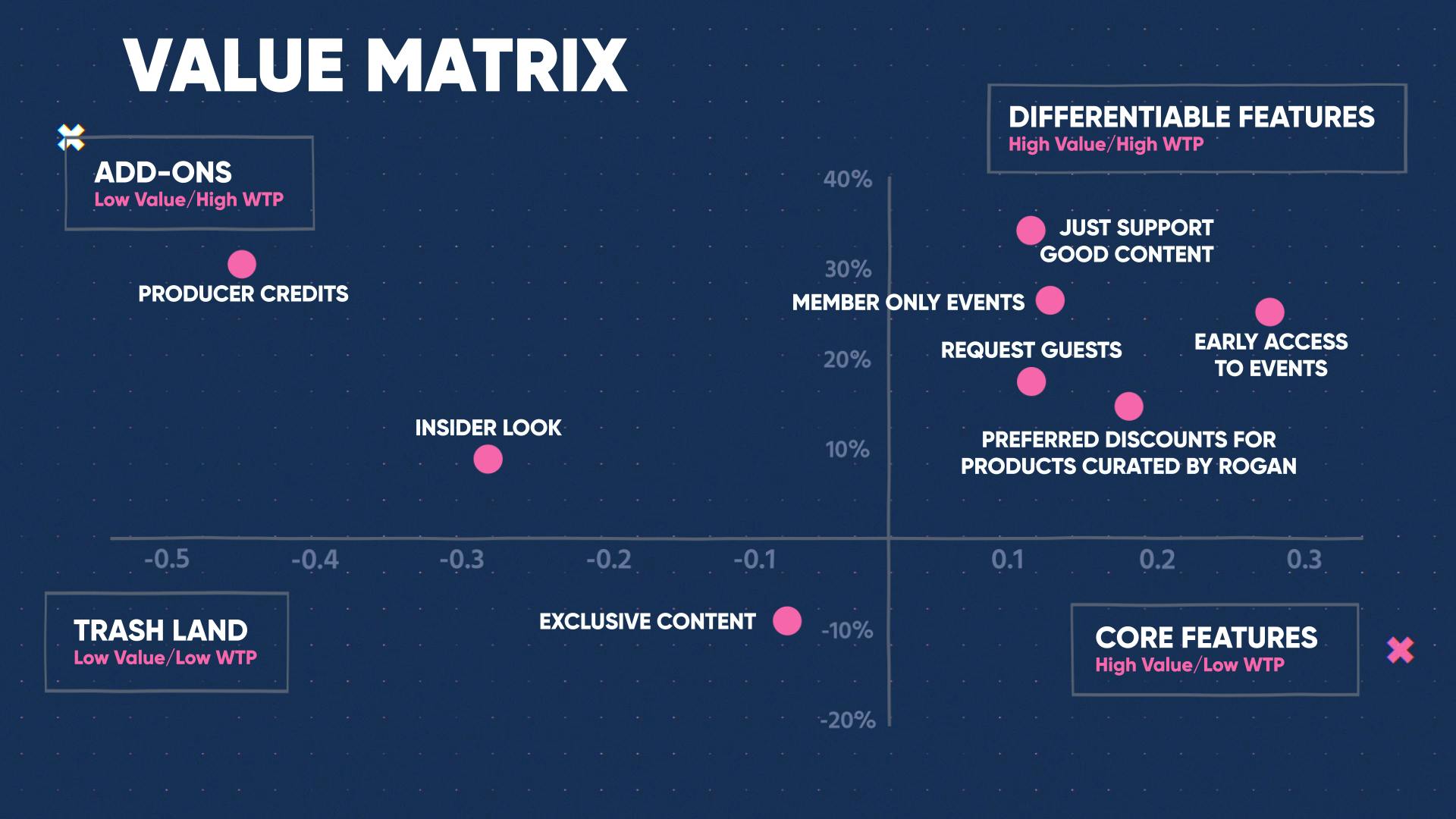
Differentiable factors are things that could drive a Rogan subscription, things like preferred discounts for products curated by Rogan. He already talks about all of these different causes and products. People are willing to pay for this stuff just to support him. I know it seems kind of crazy, but that's only because we haven't been looking at podcasts as art. We support bands. We support artists. We buy their art! Rogan's podcast is his art.
More creators need to look at this data and realize, you don't have to create exclusive content. You don't have to give an insider look or producer credits, like the traditional kickstarter model. You can just ask for the money and give a couple of things here and there. As long as you're giving value, people will continue to use it.
Would it really work?
It's interesting with Rogan in particular, because his following is so aggressive for him—they love him. But Tim Ferris has also tried to do this. A little while back, Ferris got rid of his podcast's advertising and instead tried to solicit donations. People were looking at it and they're like, "This guy's worth over a hundred million dollars." Now Joe Rogan has a deal of his own, and it might create the same dynamic. Will people pay for his content, when they already view him as a wealthy person of authority?
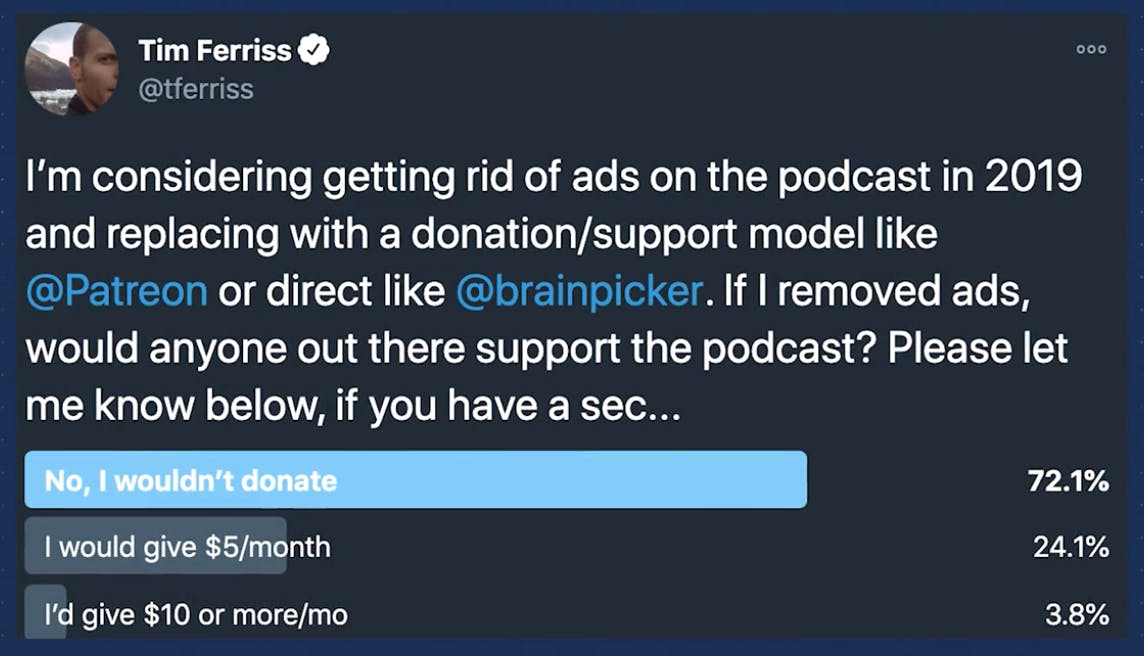
When you pivot from an ad model to a subscription model, you have to do it properly. Because Ferris didn't market his new set-up as a subscription, opting instead to just ask for "donations," people were put off. You don't think of a millionaire as needing donations. I think Joe Rogan would see the same response. The word "donation" is so strongly associated with helping people. If his podcast started asking for donations, people would be confused because Rogan doesn't need any help.
There's something here for you and your business if you're thinking of a content subscription. In a lot of situations, it's likely going to be B2B brands that have the potential to create these memberships, like a recurrent network premium subscription for different access to things. Don't worry about doing ads, because I don't think the ad model works as well as many think it does. It also pushes you to make a certain type of content, and you may not want to be limited to "brand-safe" guidelines.
- Subscriptions hedge against platform and ad fatigue. What's brilliant about a subscription is that it allows you to go for the ads you want and not worry if a platform shuts you off. Of course, you still want to stay on top platforms. But depending on your content, actions, and monetization plans, you'll appreciate the increased flexibility.
- B2B brands: Leverage your diverse offerings. It's easy to think that the only potential subscription you can have is your software. Take advantage of things like groups, events, communities, et cetera. It can help promote the rest of your offerings as well.
- Know why people like you. We saw with Rogan that the thing that people truly love about him isn't his MMA or comedy content. The deep thinkers and controversial guests drive all of his audience's willingness to pay. You need to hone in on your biggest fans.
- Membership actually improves the user experience by taking advantage of community. All of the things that people prefer inside a membership are things that listeners are already doing. All Rogan needs to do is provide a priority line or significance to those subscribers. It'll boost his revenue and strengthen the connection for them.
(00:00):
Joe Rogan is the biggest mistake that YouTube and Google have ever made.
(00:05):
Welcome to Pricing page Teardown, where the profitWell Crew breaks down strategies and insights on how subscription companies from all corners of the market can win with monetization.
(00:21):
Welcome to Pricing page Chair down. I'm Patrick Campbell. I'm Rob Litterst. And this week we are talking about a little known podcaster who is also a UFC commentator, former host of Fear Factor standup comedian. We're talking about a hypothetical Joe Rogan subscription in the world of creators, not only podcasters, but also business creators like us and our media site recur, as well as a whole host of other creators that are out there. The world of a subscription of subscribing to someone in their views or their content is starting to become more in vogue. And what we wanted to explore is basically, one, did Spotify make a great decision in the a hundred million dollar deal for exclusive rights at Joe Rogan's podcast? But two, what could Joe Rogan do to kind of not have to go to a Spotify subscription and get that freedom that he's always wanted in order to have an actual subscription that's defensive against the likes of YouTube, Spotify, apple Podcasts, et cetera?
(01:14):
Totally. And you saw it when he signed that deal with Spotify. Some people were saying that he made the mistake because he could be making more on his own. If you look at some of his advertising metrics, we'll,
(01:22):
I think this data is going to suggest that's true. Yeah. But I also think the data's gonna show that he didn't. I mean, a hundred million dollar decision is never, never a bad decision ever.
(01:30):
Yeah, he's doing
(01:31):
Okay. But in that light, we're gonna talk to you about what Joe Rogan could be doing really, really well to monetize his brand and monetize his content all within the constraints that he wants to stay in when it comes to his content. We're also gonna be talking about some of the things that he's probably not doing so well. Mm-hmm. <affirmative>. We're gonna bundle those all into a case study for your own pricing strategy, so you can make sure you get your monetization on the right track.
(01:54):
Joe Rogan just wants to learn and that's what gets him and his podcast into trouble. It's also what got him a $100 million deal from Spotify for exclusive rights to his podcast. From talking to Bernie Sanders and Alex Jones to Tulsi Gabbard and Elon Musk, as well as an endless stable of comics like Tim Dylan, Tom Segura, and Burt Kreer. Joe just wants to talk and learn from people without an agenda. This is why people love listening to his podcast, the Non Agenda Focus Questions, learning and calling BS if someone goes too far. This is also why people hate his podcast. He gives sunlight to the ideas from seemingly controversial figures, which causes controversy. Joe came a long way to this 100 million podcast empire, though growing up in New Jersey, a bit of time in California, and then Boston. Joe had a good but tough childhood. He found his journey in martial arts when he started lessons at the age of 13 before touring the country in tournaments and even thinking he'd go pro.
(02:50):
As Joe said, martial arts gave me not just confidence, but also a different perspective of myself from what I was capable of. I knew that I could do something I was terrified of and that was really difficult and that I could excel at it. It was a big deal for me. That confidence led to four years of Massachusetts full contact TaeKwonDo Championships. Some head trauma convinced him to shift his career down a less violent path. So at the age of 22, handed the aggressive Boston comedy scene using his determination and confidence learned in fighting. Joe Rose the comedy ranks, moved to LA and found success in comedy specials sitcoms like News Radio and Hardball, as well as being a longtime color commentator with the UFC since 1997. You also probably know him most from his longtime hosting gig of Fear Factor, which let's just say he has some stories.
(03:36):
In 2009, he started his podcast, the Joe Rogan experience, just as the way to talk to his comic friends. Although Joe admits the early episodes were terrible within a decade, the show gained a massive following with 190 million monthly downloads, especially as his guest list expanded to scientists, authors, political figures, athletes, artists, and really just anyone that Joe finds interesting. Clearly many other find them interesting too, as Spotify convinced Joe to go exclusive with that 100 million deal, Joe's success stems from trying to seek the truth. A refreshing notion in this day and age, yet some critics question whether or not the 100 million deal was good for Spotify, let alone Joe considering he lost some of his audience who didn't or couldn't move to Spotify. He did keep his editorial freedom, but could there have been more financial freedom for Joe's staying independent? So the question becomes, how should Joe Rogan monetize his audience in a matter to not only gain financially, but also pull the community together? Is Spotify monetizing Joe's content properly through ads? Should Joe have a subscription like other artists and creators are doing? It seems Joe's doing many things right? But we're gonna explore how he could be doing even more by collecting data from current and prospective Joe Rogan fans will reveal all the data and answers to these questions coming up in just a bit.
(04:49):
Do you listen to Joe? I love Joe Rogan. Um, I don't listen to him regularly. Yeah. But I listen to like probably maybe like 10 podcasts of his year or something like that. Oh, interesting. That's not a lot though. No. Publishes a lot. Yeah, he does. I, I got sucked in Uhhuh via video clips. Uh Okay. On YouTube and then all of a sudden it was just in my feed. Yeah. I was like, oh, I'll listen to that. Oh, I like Tom Sagura. Oh, I like this. But I think he, he just likes to talk to people who are super interesting. Yep. And he likes to understand. And I think that when you're a content creator, that's something where you're not making it about you. You're making it about the guest. And when you're a listener, that just allows you to have these really interesting guests where you're not getting in front of them.
(05:30):
Totally. And he's done a really good job of keeping himself kind of, not necessarily apolitical, but he has guests that are, they're really on a gamut of kind of like where they come. He's not safe. I think from a monetization perspective, um, Rogan does have some constraints. He likes doing what he does and there's so many things he know would make more money. Right. But he does not want to do more. He wants to just kind of keep doing the same stuff and he doesn't wanna be anyone else's like employee. He wants, he wants to be his own boss. And so with that, what we're basically do is under those constraints, we're gonna talk through what a Joe Rogan subscription could look like and ultimately how you can monetize either a subscription to your content or just a subscription in general in the right way in order to make sure your monetization is on the right path. Let's jump in.
(06:11):
So where does our data come from? Here at ProfitWell, our Price Intelligently product combines proprietary algorithms and methodologies with a team of pricing experts who think about this stuff more than anyone else, to help companies optimize their monetization strategy. We do this by going out into the market and collecting data from current and prospective customers. Having the ability to collect data from everyone from a soccer mom or dad in the middle of Kansas all the way to a Fortune 500 CIO in South Africa. We then take that data and run it through our algorithms and analyze it in every direction to determine a company's ideal customer profiles, as well as which segments value which features and which segments are willing to pay more. All in the spirit of determining how a company can use monetization for growth oath.
(07:00):
So first up, a subscription hedges against basically platform and ad fatigue. So one thing that we've noticed with creators in the past is that basically they'll, there will be a personality who will just get knocked off a particular platform and it completely, you know, takes them down, derails them, right, derails them. Now a lot of these folks are a little bit more controversial. Again, there's definitely platform problems and there's also ad problems. Mm-hmm. <affirmative>, there's a lot of creators who want to create, you know, hour long shows and they want to go really, really deep into hour long episodes of something. But that content is great from a length perspective, but it's not necessarily enough volume or you can't do that enough volume in order to create enough in order to be successful. And so when you're seeking those thousand true fans, that model just doesn't work from an ad platform perspective.
(07:44):
Right. It works a lot more from a subscription perspective. Mm-hmm. <affirmative>. And the first thing we wanna do is we wanna collect willingness to pay data in order to understand even the feasibility of a fan or someone paying someone like Joe Rogan enough per month to sustain his particular lifestyle or his business. I can't wait to see this data. What we did is we first measured essentially Affinity for Joe Rogan. Mm-hmm. <affirmative>, like did you have a neutral or a weak affinity or even a negative affinity versus hey, do you have moderate, you're probably in the moderate range. Yeah. Moderate. And then someone who's kind of in the strong affinity, they listen to every single episode, they go to his shows, they like to read his content, maybe they go to a Reddit section or so on Joe Rogan every so often. And what was really kind of fascinating is the willingness to pay on the weak side.
(08:25):
You know, it was like one to $2. Okay. So this is pretty close to zero mm-hmm. <affirmative>. Um, which is interesting. And obviously these people probably aren't primed to like pay anything to support Joe Rogan. They could probably be kind of, I don't wanna say swindled, but they could probably convince with some sort of offer in order to sign up for a subscription, but Joe probably wouldn't target these people on. Yeah. And I would suggest most content folks, you shouldn't worry about these people who don't have fandom with you. You should focus on the people who have like positive or strong, positive affinity for you. Because as you can see here, the moderate to strong folks, they're all of a sudden five to almost $15 per month Totally. For a subscription. And if you really think about that as, you know, a hundred bucks per year, all of a sudden that's something where, you know, he could basically have for a subscription in addition to all of the different ad revenue that he might have. Cuz this doesn't mean he doesn't have to have ads either. It's
(09:11):
Really crazy. Like he ha he could even break it down into different subscriptions based on his kind of verticals, if you will. Like he has kind of MMA that he tackles, then comedy and then the kind of thinking bunch. It's like he has the opportunity to really kind of
(09:23):
Monetize this out. Totally. And I'm really glad you said that because I think the other thing you have to understand if you're creating content oh, is you have to understand why people appreciate your brand. And the thing that you just said in terms of like willingness to pay, we basically broke down like, Hey, what's the number one reason you listen to Joe Totally. Or you kind of like consume his content. And then in addition to that, like cross-referencing that with a willingness to pay. And what you'll find out is that his MMA content, those people who really like the MMA content, they're not willing to pay much at all. Yeah. Um, they're relative willingness to pay is is basically zero. Right. Um, even the comedy folks, it's basically zero. But the folks who really, really like the academic or political commentary or even the controversial guests, those are the target that really, really appreciate Joe Rogan.
(10:03):
And those are also the folks who put him most at risk on the platform. Right. Because I, I believe, I don't know if that's true or not, but one of the reasons he was going to Spotify is because YouTube, he wanted to interview some controversial doctors, you know, during the Covid crisis. But YouTube basically said anything related to Covid is gonna get demonetized. Wow. Which probably was globally the right decision. Uhhuh <affirmative>. But for someone like Joe Rogan, it's like hey, those are the guests that are most interesting to his Right. His his users or his listeners. And so I think the big takeaway for your business is like if you're doing something in the content space, but let alone like any sort of subscription, you gotta go after the super fans and you got a price base on those super fans. Totally. Because I almost guarantee you that those MMA folks, those comedian guest folks, or even those folks who have weak affinity, they're gonna churn out anyways. Right. So why build the subscription? Why build the brand around them, build the brand around the folks who are not only gonna pay you, but also be the biggest drivers of more users.
(10:51):
Totally.
(10:51):
And then finally, membership actually improves the user experience by taking advantage of community. Mm-hmm. <affirmative> note, we talked about how Rogan doesn't want, like Rogan doesn't want to create a bunch of swag and like do these types things. No, he could probably outsource it and he could probably convinced based on some of the data that we're about to show, Rogan has like this following of people who are like, oh yeah, I'll go to his events. Right. It really hinges on community. Mm-hmm. <affirmative>, well you're looking at here is a value matrix.
(11:18):
You're about to see something called a value matrix. Here we collected data from the group comparing feature preferences and plotted those on the horizontal axis. More valued features on the right, less valued on the left. We then collected willingness to pay for the overall product and plotted that base on their number one feature preference on the y-axis. Analyzing data in this manner allows us to determine which features are differential add-ons, core or commoditize for each segment.
(11:48):
Basically in this differential, these are the things that would drive a subscription. Mm-hmm. <affirmative>, there's things preferred discounts for products curated by Rogan. Wow. He already talks about, whoop, he already talks about all these things on it, you know, fight for the forgotten charity. You know, he talks about the cash app, all these different things. Um, early access to events, being able to request guests. You don't even have to listen to them. Just give him the ability to request guests. Probably, um, member only events, just supporting good content. Like people are willing to pay for this stuff just to support him. Oh yeah. And I know that seems kind of crazy because I think a lot of people don't really think about that, but like, we support bands, we support artists. Normally we buy their work, but his art is basically his podcast. Right. Absolutely. And I think that more creators need to look at stuff like this and realize that like, you don't have to create exclusive content. I don't think Rogan would want to create exclusive content. You don't have to give an insider look. You don't have to give producer credits like the traditional kind of Kickstarter things that existed mm-hmm. <affirmative>. But you can just like ask for the money and give some like couple of things here and there. And as long as you're like giving value, people will continue to use it.
(12:50):
Right. It's interesting with Rogan cuz his, his following is just so kind of aggressive for him and and they love him. Yeah. But Tim Ferris tried to do this right, like a little while back. Yeah. Tim Ferris got rid of his advertising on his podcast and tried to solicit donations essentially. And people were looking at it and they were like, this guy's worth over a hundred million. Which now Joe Rogan has a deal, it's over a hundred million dollars. It's kind of an interesting dynamic. It's like, will people pay for it? I
(13:15):
Don't know. Yeah. I think pivoting from an ad model to a subscription model, you have to do it properly. Totally. I think in my opinion with Tim Ferris, I think that he made it a little bit more too donation. Yeah. He should have just had a subscription, right? Like, hey, we're just gonna move to a subscription model. Right. Like you look at someone like Sam Harris and Sam Harris basically does early access to event tickets, member only events. He does a couple of these different things. They don't want him pushed by advertisers. Right. They like him to be as intellectually honest as possible. Hundred percent. At least his, his, you know, subscribers and you can quibble with the things he says if you would like. But I think that that was the problem with kind of a donation model. Totally. It's like it donation has a very like, strong connotation for helping someone.
(13:56):
Yeah. Yeah. Joe Rogan doesn't need any help. It's the optic guy's not enough money to live. He doesn't need anything like that. I dunno, I think there's something here. And for you in your business, I think if you're thinking you of a content subscription, I I think there's gonna be more B2B brands that have content subscriptions on some level. Totally. Um, like a recur premium, uh, recurring network, premium subscription for different access to things go for the thousand true fans. Mm-hmm. <affirmative>, like, don't worry about necessarily doing ads because I don't think the ad model works, um, as well as you would think it does. Right. It's just, and it also like pushes you to like have certain type of content which you might not want to create brand safe content. Right. If that's okay.
(14:35):
So let's recap. First up, subscriptions hedge against platform and ad fatigue. I think what's brilliant about a subscription is that it allows you to basically have the ability to kind of go for the ads you want and not worry if a platform shuts you off. Obviously you wanna stay in those platforms, but depending on the content you're producing, depending on what you're doing, and ultimately depending on like how you wanna monetize it gives you a lot more flexibility. Totally. Now for B2B brands, I think the big thing to kind of keep in mind here is that don't think that the subscription that you only can have as your software, there's other things that you can have subscriptions to groups, events, communities, et cetera. And it can kind of hedge the rest of the software that you have as well. Totally. Next up, understand why people appreciate your brand.
(15:17):
We talked about this with Rogan, no willingness to pay from the MMA crowd from the comedy crowd. Yeah. It's really the deep thinkers in the controversial guests that are driving all that willingness to pay if you were to ever to push this forward. I mean, he's gotta really hone in on that guy, which I would argue, I mean he does. I don't think he has to change anything to be honest. That's true. That's true. I think you could just, I think honestly it's just like making sure that those people exist mm-hmm. <affirmative> and I think that people just love him anyways and it's probably gonna bring in more users or more listeners anyways. Totally. And then finally, membership actually improves the user experience by taking advantage of community. What we found with Rogan is that all of the things that people preferred inside a membership, they were all things that probably members are already doing or people who listen to him already are doing. It's just kind of taking a path and maybe providing a little bit of a front of the line or priority line, um, uh, significance. Mm-hmm. <affirmative> to those subscribers to actually not only boost like, you know, his, his revenue, but also boosts like the connection with him. Right. Which I think is what a lot of people want. Absolutely.
(16:15):
Well, that's all for this week's episode of Pricing page. Teardown. If you got some value from this, if you learn something, make sure you share this on the social media channel of your choice. Wanna make sure we get this information in the hands of as many people as humanly possible to make sure that they're continuing to learn and we're evangelizing the whole world pricing learning. And of course, if you want data like this or you have some pricing questions, feel free to reach out to me@patrickprofitwell.com or@robprofitable.com and we'll hook you up with the right people internally to get more information about our price intelligently software from ProfitWell, who's up next week. Next week. We have a fascinating B2B K study. We're going back to our roots in terms of B2B software here. All right, let's go. We'll be talking about monday.com. Okay. Which I'm sure you've seen YouTube ads for. Oh yeah. You might not be sure what they do, but I think that they've revolutionized the next wave of project management software with really, really good design. But unfortunately they're making a couple of pricing decisions that I think they're costing them millions. Awesome. We'll see you next week.
